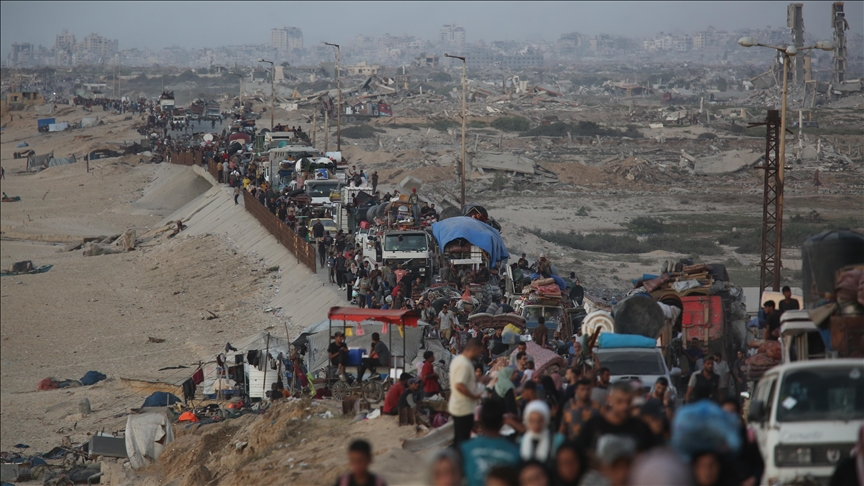Israeli military advance in Gaza City remains slow, tied to pace of Palestinian displacement: Analyst
Doron Kadosh says forces advancing cautiously while delay in evacuations holds back entry of additional division
 Palestinians flee with their belongings loaded on vehicles and carts as others walk along Rashid Street towards the south of Gaza, following intensified Israeli airstrikes and evacuation orders in the northern areas of the enclave in Gaza City, Gaza on September 17, 2025.
Palestinians flee with their belongings loaded on vehicles and carts as others walk along Rashid Street towards the south of Gaza, following intensified Israeli airstrikes and evacuation orders in the northern areas of the enclave in Gaza City, Gaza on September 17, 2025.
JERUSALEM/ISTANBUL
An Israeli military analyst said Thursday that the army’s ground advance in Gaza City has been moving slowly and is closely linked to the pace of Palestinian displacement.
Doron Kadosh, reporting for Army Radio, said the 162nd and 98th divisions have been pressing in from two directions but “continue to advance at a slow pace.”
Senior commanders, he said, are describing the current phase as a “probing stage,” with troops moving gradually rather than storming the city center.
According to Kadosh, Hamas fighters entrenched in the heart of Gaza City have largely stepped back to study Israeli movements, avoiding direct confrontations for now.
He added that the scale of the maneuver is being dictated by the speed at which Palestinian residents leave their homes.
The army delayed deploying the 36th Division for several days “because the evacuation process was too slow,” he said.
While the division was initially meant to enter alongside the other two, it will likely join “in the coming days as the pace of departures increases,” Kadosh said.
The analyst also cited criticism within Israel’s defense establishment that the Southern Command initially opened only one evacuation route, the Rashid coastal road, creating bottlenecks and slowing the process.
A second corridor, Salah al-Din Street, was opened only later to ease congestion.
He further claimed that roughly two-thirds of Hamas fighters in Gaza City had already fled south toward what Israel calls “humanitarian areas,” and that many fighters remain underground awaiting the army’s approach.
The Jerusalem Post reported that Gaza City’s population stood at over 1 million before the Israeli assault began last month, but that more than 400,000 have since fled following the demolition of high-rise residential blocks.
On Tuesday, the army expanded its offensive in Gaza City, though local witnesses said no full-scale incursion had taken place. Instead, Israel has intensified shelling, airstrikes and home demolitions using booby-trapped robots, in what Palestinians describe as part of a campaign of mass displacement.
In August, Israel’s government approved Prime Minister Benjamin Netanyahu’s plan to fully reoccupy the Gaza Strip, beginning with Gaza City. The assault began on Aug. 11 from the eastern Zeitoun neighborhood under Operation Gideon’s Chariots 2, involving heavy bombardment, demolitions and forced displacement.
The Israeli army has continued a brutal offensive on the Gaza Strip, killing more than 65,100 Palestinians since October 2023. The military campaign has devastated the enclave and forced the population into famine.
On Tuesday, the UN Independent International Commission of Inquiry on the Occupied Palestinian Territory confirmed that Israel had committed genocide in Gaza.
Anadolu Agency website contains only a portion of the news stories offered to subscribers in the AA News Broadcasting System (HAS), and in summarized form. Please contact us for subscription options.







